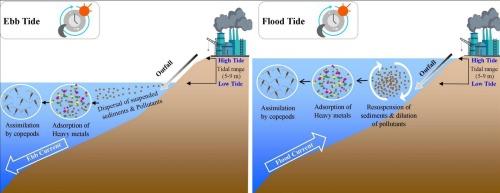印度西北海岸近岸重金属负荷的潮汐控制
IF 8
1区 环境科学与生态学
Q1 ENVIRONMENTAL SCIENCES
引用次数: 0
摘要
重金属在海洋食物链中积累,其过量对水生生物和人类的生命都是有害的。本研究提出了生态系统变量,特别是潮汐在决定印度西海岸海水和桡足动物中10种重金属(Fe, Zn, Cu, Co, Cr, Mn, Ni, V, Pb和Cd)存在的作用。印度西北海岸是一个工业中心,成千上万的工业排放着大量的污水,而西南海岸的工业数量要少得多。对印度西海岸近岸8个海洋排水区的表层海水和浮游动物样本进行分析,结果表明,Fe/Cd在海水和桡足类动物中分别最高/最低(分别为184±12.40 μg / 0.01±0.01 μg L - 1)和41818±2867 μg。G−1/ av. 0.2±0.02 μg−1)。海水/桡足类动物中重金属总体表现为Fe/Fe >;锌/锌比;V /锰比;Cr / Cr比;Pb /铜比;镍/镍比;铜/铅比;Mn / V比;有限公司/有限公司在Cd / Cd。与预期相反的是,尽管印度西北海岸的海水中充斥着来自数千家工业的大量废水,但大多数重金属含量并不高于西南海岸。这里显示,这一特征是西北印度海岸(7米潮汐)的大潮汐性质的结果,那里的潮汐流、沉积物再悬浮和冲刷比西南(1米潮汐)要强烈得多,从而降低了污染水平。然而,印度西北海岸桡足类动物的海洋污染指数和重金属生物积累因子最高,这是制定该地区环境管理战略时应考虑的重要指标。本文章由计算机程序翻译,如有差异,请以英文原文为准。

Tidal control of heavy metal loading in the nearshore of the northwestern Indian coast
Heavy metals accumulate in the marine food chain and their excessive amounts are hazardous to aquatic and human lives. The current study presents the role of ecosystem variables especially tides in deciding the presence of ten heavy metals (Fe, Zn, Cu, Co, Cr, Mn, Ni, V, Pb, and Cd) in seawater and copepods along the Indian west coast. The Indian northwestern coast is an industrial hub, where thousands of industries release enormous volumes of effluents, while the southwest coast has a far lower number of industries. Multiple surface seawater and zooplankton samples from eight selected marine outfall regions in the nearshore of the Indian west coast showed that Fe/Cd was generally the highest/lowest in seawater (av. 184 ± 12.40 μg L−1/ av. 0.01 ± 0.01 μg L−1) and copepods (av. 41,818 ± 2867 μg. g−1/ av. 0.2 ± 0.02 μg g−1). The heavy metals in seawater/copepods generally showed the order Fe/Fe > Zn/Zn > V/Mn > Cr/Cr > Pb/Cu > Ni/Ni > Cu/Pb > Mn/V > Co/Co > Cd/Cd. Contrary to expectations, despite being loaded with massive amounts of effluent from thousands of industries, most heavy metals in seawater on the northwestern Indian coast were not higher than on the southwestern coast. It is shown here that this feature is the result of the macro-tidal nature of the northwest Indian coast (av. 7 m tide), where tidal currents, sediment resuspension, and flushing are far more intense than in the southwest (av. 1 m tide), which reduce pollution levels. Yet, the marine pollution index and bioaccumulation factor of heavy metals in copepods was found highest along the northwestern Indian coast, which are important indicators to be considered when developing environmental management strategies for the area.
求助全文
通过发布文献求助,成功后即可免费获取论文全文。
去求助
来源期刊

Science of the Total Environment
环境科学-环境科学
CiteScore
17.60
自引率
10.20%
发文量
8726
审稿时长
2.4 months
期刊介绍:
The Science of the Total Environment is an international journal dedicated to scientific research on the environment and its interaction with humanity. It covers a wide range of disciplines and seeks to publish innovative, hypothesis-driven, and impactful research that explores the entire environment, including the atmosphere, lithosphere, hydrosphere, biosphere, and anthroposphere.
The journal's updated Aims & Scope emphasizes the importance of interdisciplinary environmental research with broad impact. Priority is given to studies that advance fundamental understanding and explore the interconnectedness of multiple environmental spheres. Field studies are preferred, while laboratory experiments must demonstrate significant methodological advancements or mechanistic insights with direct relevance to the environment.
 求助内容:
求助内容: 应助结果提醒方式:
应助结果提醒方式:


